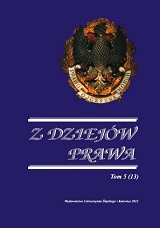Problematyka konstrukcji prawnej organizacji administracji publicznej w doktrynach prawnoadministracyjnych przełomu XIX i XX wieku
The issue of the legal structure of a public administration in legal-administrative doctrines at the turn of the 19th and 20th centuries
Author(s): Grzegorz SmykSubject(s): Law, Constitution, Jurisprudence
Published by: Wydawnictwo Uniwersytetu Śląskiego
Summary/Abstract: The issue of the organizational unification of administrative structures constituted one of the most discussed subjects in the legal-administrative literature of the 19th century. Two contradictory systems of the organization of the public administration, a real and provincial one, were analysed in terms of its advantages and disadvantages. A real system was understood as a subjective division of duties of the state administration into selected organizational structures of the organs subject to a given department at the central level. The problem of mutual relations between central and local organs of the administrative management of the country combined the subject of the real and provincial system with the issue of centralization and decentralization of administration. The theory of the administrative law combined the real system with the model of centralized administration, seeing in it an organizational system, consisting in a hierarchical arrangement of the whole administrative apparatus to one or several central organs in which the lower-level organs are deprived of an organizational independence while their activity is subject to a constant interference of superior organs. The issue of centralization and decentralization was tightly connected with concentration and deconcentration. The 19th century theory of an administrative law mixed the very notions, identifying concentration with centralization and deconcentration with decentralization. However, concentration was understood as a concentration of decisive competences only under the administration of central organs, especially the ministers. In consequence, deconcentration was treated as a form of centralized administration, characterised by a specific type of relations of a hierarchical interdependence between the organs functioning in decentralised structures.
Journal: Z Dziejów Prawa
- Issue Year: 13/2012
- Issue No: 5
- Page Range: 109-120
- Page Count: 12
- Language: Polish

